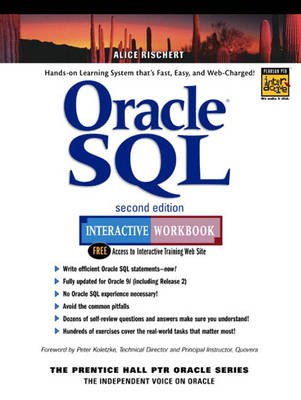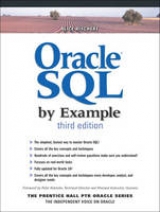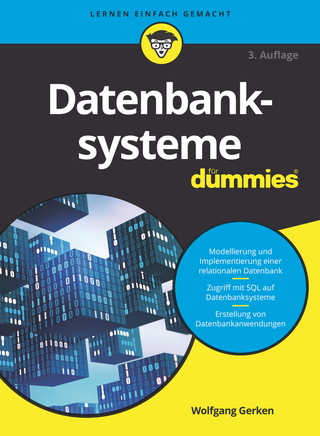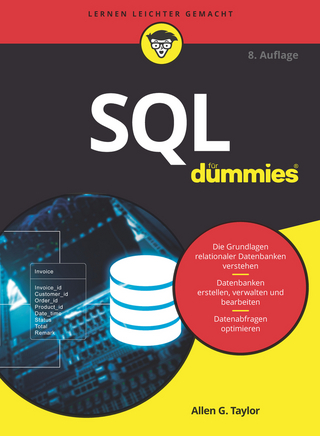
Oracle SQL Interactive Workbook
Prentice Hall (Verlag)
978-0-13-100277-7 (ISBN)
- Titel erscheint in neuer Auflage
- Artikel merken
Appropriate for beginning to intermediate courses in Oracle SQL.
Fully updated and expanded for Oracle 9i, this integrated book-and-Web learning solution is designed to help students master SQL on Oracle Systems as quickly as possible. Its unique workbook-based pedagogy incorporates hands-on, real-world labs, exercises, and projects, as well as an outstanding Web-based training site containing “Test Your Thinking” project solutions and detailed explanations, an Author's Corner that connects students with the book's expert author; additional self-review exercises with instant feedback and explanations; and an exclusive Virtual Study Lounge where students can interact with each other. The book's coverage includes every fundamental SQL concept, skill, and technique, including entity-relationship diagrams, SQL*Plus, SELECT and other statements, Boolean operations, functions, pseudocolumns, joins, complex joins, subqueries, relational operators, DML, DQL, DDL, and the Oracle Data Dictionary.
ALICE RISCHERT chairs the Database Application Development and Design track at the Computer Technology and Application Program at Columbia University. She has taught Oracle SQL to hundreds of students and has presented at Oracle conferences. Rischert has worked with Oracle for over 10 years and currently consults on large Oracle data warehouse and system integration projects. Foreword by Peter Koletze
(NOTE: All chapters conclude with Test Your Thinking.)
Foreword.
Acknowledgments.
About the Author.
Introduction.
1. SQL and Data.
Data, Databases, and the Definition of SQL. Table Relationships. The Student Schema Diagram.
2. SQL: The Basics.
The SQL*Plus Environment. The Anatomy of a SELECT Statement. Editing a SQL Statement. The WHERE Clause: Comparison and Logical Operators. The ORDER BY Clause.
3. Character, Number, and Miscellaneous Functions.
Character Functions. Number Functions. Miscellaneous Single-]Row Functions.
4. Date and Conversion Functions.
Applying Oracle's Date Format Models. Performing Date and Time Math. Using the New Oracle 9i DATETIME Datatypes. Performing Calculations with the INTERVAL Datatype. Converting from One Datatype to Another.
5. Aggregate Functions, Group By, and Having.
Aggregate Functions. The GROUP BY and HAVING Clauses.
6. Equijoins.
The Two-Table Join. Joining Three or More Tables.
7. Subqueries.
Simple Subqueries. Correlated Subqueries. Inline Views, Scalar Subquery Expressions, and the Subquery WITH Clause. ANY, SOME, and ALL Operators in Subqueries.
8. Set Operators.
The Power of UNION and UNION ALL. The MINUS and INTERSECT Set Operators.
9. Complex Joins.
Outer Joins. Self-Joins.
10. Insert, Update, and Delete.
Creating Data and Transaction Control. Updating and Deleting Data.
11. Create, Alter, and Drop Tables.
Creating and Dropping Tables. Altering Tables and Manipulating Constraints.
12. Views, Indexes, and Sequences.
Creating and Modifying Views. Indexes. Sequences.
13. The Data Dictionary and Dynamic SQL Scripts.
The Oracle Data Dictionary Views. Dynamic SQL Scripts.
14. Security.
Users, Privileges, Roles, and Synonyms.
15. Advanced SQL Queries.
Advanced SQL Concepts and Analytical Functions. ROLLUP and CUBE Operators. Hierarchical Queries.
16. SQL Optimization.
The Oracle Optimizer and Writing Effective SQL Statements.
Appendix A. Answers to Self-Review Questions.
Appendix B. SQL Formatting Guide.
Appendix C. SQL*Plus Command Reference.
Appendix D. Student Database Schema.
Appendix E. Table and Column Descriptions.
Appendix F. Additional Example Tables.
Appendix G. Navigating through the Oracle Documentation.
Appendix H. Resources.
Index.
| Erscheint lt. Verlag | 8.1.2003 |
|---|---|
| Verlagsort | Upper Saddle River |
| Sprache | englisch |
| Maße | 235 x 231 mm |
| Gewicht | 1202 g |
| Themenwelt | Mathematik / Informatik ► Informatik ► Datenbanken |
| Mathematik / Informatik ► Informatik ► Software Entwicklung | |
| ISBN-10 | 0-13-100277-5 / 0131002775 |
| ISBN-13 | 978-0-13-100277-7 / 9780131002777 |
| Zustand | Neuware |
| Informationen gemäß Produktsicherheitsverordnung (GPSR) | |
| Haben Sie eine Frage zum Produkt? |
aus dem Bereich



